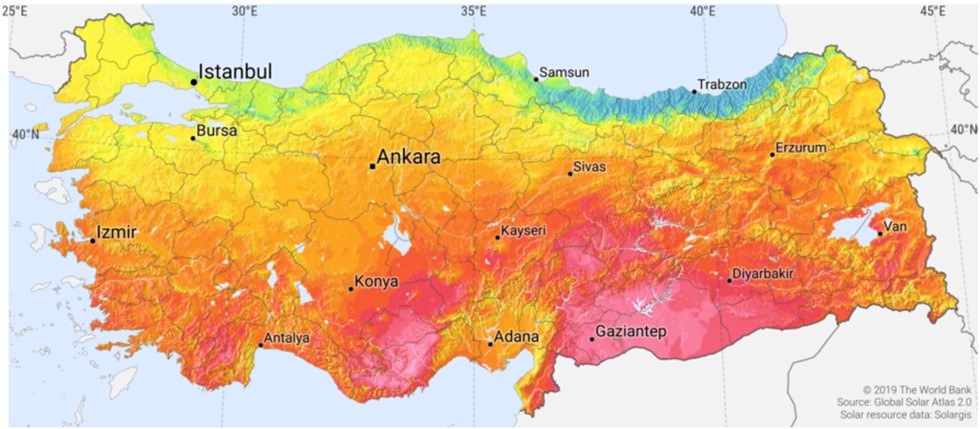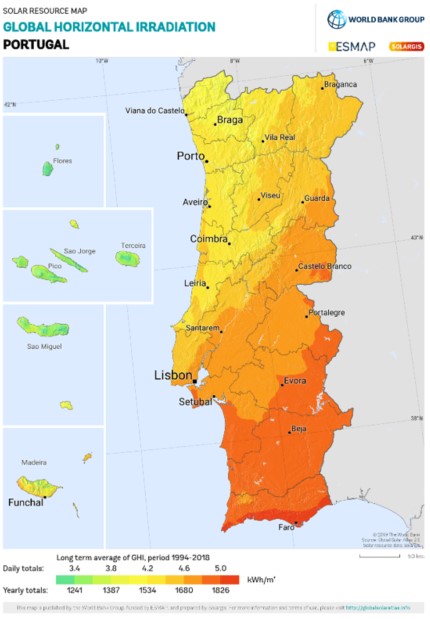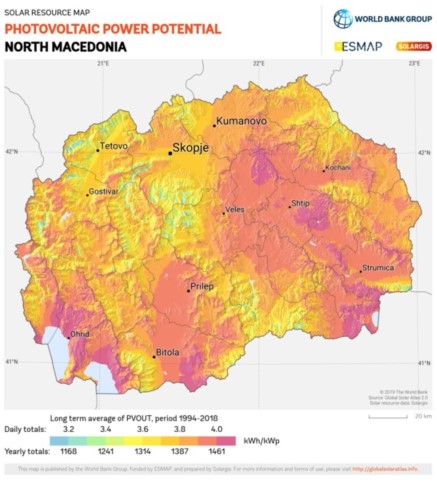- Definition and Types of Energy
- Myths And Misconceptions About Energy
- The Relationship Between Energy and Environment
- Climate Change and Carbon Footprint
- Greenhouse Gas Effect
- The Role of Human-Induced Greenhouse Gases and Energy Consumption
- Energy Efficiency and Sustainability
- Renewable Energy Sources and Future Perspectives
- Play and Learn
- Solar Energy Conversions
- Solar Energy Worldwide
- Solar Energy in Partner Countries
- Positive and Negative Impacts
- Technologies for Harnessing Solar Energy
- Solar thermal energy technologies and applications
- Electricity Generation Methods
- Passive Heating and Cooling of Residences with the Sun
- Concentrator solar power (CSP) systems and electricity generation
- Systems and Applications That Generate Electricity directly from solar rays
- Photovoltaic Cells and Panels
- Domestic PV Systems
- Off-Grid PV Systems
- Hybrid Connected Systems
- Materials Used in PV Cells
- Play and Learn
Solar Energy in Partner Countries
Solar Energy in Türkiye
Türkiye is located within the Solar Belt and has an average of 2,737 hours of sunshine per year. The annual solar radiation varies between 2.9 and 4.0 kWh/m² across different regions. According to the Türkiye Solar Energy Potential Atlas (GEPA), the regions with the highest solar potential are the Mediterranean Region and the area around Lake Van, while the regions with the lowest potential are the Black Sea and Marmara regions.

As of February 2016, Türkiye had 313 solar power plants with a total installed capacity of 313 MW. The largest of these plants was the Konya Karatay Kızören Solar Power Plant, with a capacity of 18 MW. At that time, various incentive and support mechanisms were in place to increase the use of solar energy in Türkiye. However, as of February 2025, Türkiye's installed solar capacity has significantly increased to 12,425 MW. This rapid growth is a result of Türkiye's commitment to renewable energy sources and the incentives provided. According to the Ministry of Energy and Natural Resources, more than 51% of the total electricity production in January and February came from renewable energy sources. The ministry aims for an annual increase of 5,000 MW in renewable energy capacity by 2035. Türkiye's solar energy potential and current installed capacity make a significant contribution to its energy independence and sustainability goals.
Solar Energy in Portugal

The total annual average number of sun hours in Portugal ranges from a minimum of 2200 in the North to more than 3000 hours in the South, making the country suitable for a wide use of solar energy. The southern part of the country is mainly flat, in contrast to the North, which explains why most of the biggest photovoltaic power stations are located in Ribatejo, Alentejo, and Algarve. One of the largest facilities opened in 2024, “Central da Cerca”, located about 50 km north of Lisbon, has 310 thousand double-sided panels and will produce about 330 GWh per year. This energy will be enough to supply 100 thousand families and avoid the emission of at least 170 thousand tons of CO2 each year.
According to the Portuguese official Agency of Energy (DGEG), 5.9 GW of the 20.8 GW renewable power used in the country comes from solar photovoltaic. This value is more than twice the capacity installed by the end of 2022. In 2024, 1.77 GW of new solar power was added to the grid. By 2026, solar energy will surpass wind energy to become the second most important source concerning installed capacity. Several new photovoltaic projects are being developed in Portugal. They are expected to be in force by the end of 2026, with the installed capacity increasing to around 9 GW. This means that by then, photovoltaic energy will become the main electricity production technology used in the country.
Solar Energy in Greece
Greece, benefiting from its location within the Sun Belt, experiences high solar irradiance, with average global horizontal irradiation levels exceeding 1,500 kWh/m² annually. This favorable climate has propelled significant growth in the country's solar energy sector. In 2023, photovoltaics generated 19% of Greece's electricity, positioning the nation second globally in electricity production from solar energy. By the end of 2024, Greece's cumulative installed photovoltaic capacity reached 9.6 GW, a substantial increase from 5.3 GW in 2022. This rapid expansion is attributed to supportive policies, favorable climatic conditions, and a strong commitment to renewable energy. Looking ahead, Greece aims to achieve an 82% share of renewables in electricity generation by 2030, with solar energy playing a pivotal role in this transition.
A notable example of Greece's commitment to renewable energy is the transformation of Chalki, a small island in the Aegean Sea. As part of the "GR-eco Islands" national initiative, Chalki inaugurated a 1 MW solar park in November 2021, which now supplies clean energy to its approximately 300 permanent residents. The project involved the construction of a solar park and the establishment of an energy community, in which the municipality holds a 50% share. This initiative not only provides energy autonomy but also serves as a model for sustainable development across other Greek islands. The "GR-eco Islands" initiative reflects the Greek government's dedication to promoting green and digital transformation, aiming to decarbonize islands and enhance energy self-sufficiency through renewable energy and technological innovations.

Solar Energy in North Macedonia
North Macedonia, located in the Balkan Peninsula, enjoys a favorable climate that provides significant solar energy potential. The country receives between 1,500 and 1,700 kWh/m² of solar radiation annually, making it an ideal location for solar energy development. The highest solar energy potential is observed in the southern and eastern regions, which are characterized by abundant sunlight throughout the year.
As of 2023, North Macedonia's solar energy sector has made impressive strides. The country’s installed solar capacity has reached around 200 MW, with key projects such as the Oslomej Solar Park, built on the site of a former coal mine, playing a critical role in advancing the country's renewable energy transition. This project, along with others, is helping reduce the nation’s dependence on fossil fuels, particularly coal, and increasing the share of renewables in its energy mix.
The government of North Macedonia has set ambitious renewable energy goals, targeting a 50% share of renewables in its energy mix by 2030, with solar energy playing a central role in this transition. To support this, the government is providing incentives and creating favorable policy frameworks to attract both large-scale investments and encourage residential solar installations.
Notable examples of solar energy development in North Macedonia include the Skopje Solar Park, one of the country's significant solar power projects, and smaller-scale solar installations in rural areas. These initiatives not only contribute to increased energy self-sufficiency but also help reduce CO₂ emissions, aligning with North Macedonia's broader environmental and climate goals.
With continued investment in solar energy, North Macedonia is well on its way to becoming a leader in the renewable energy sector in the Balkans, further diversifying its energy sources and promoting sustainability.
